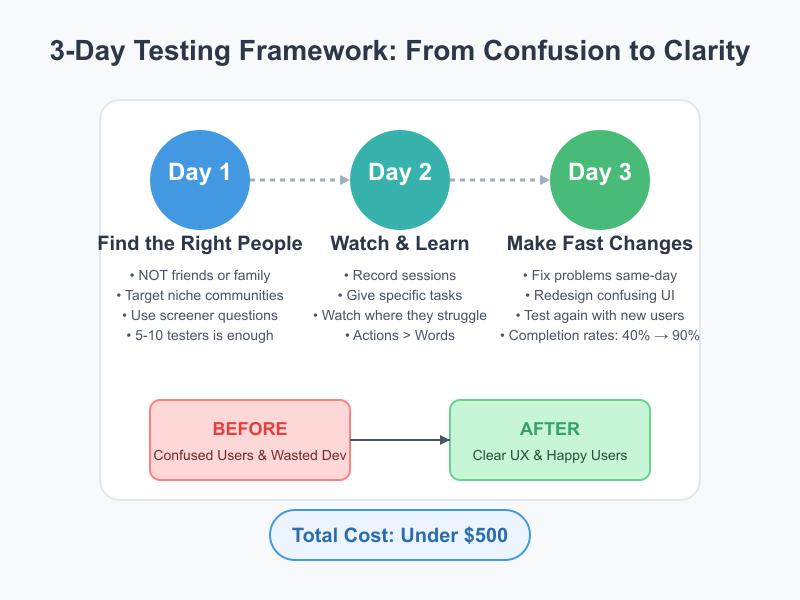- Product Upfront AI
- Posts
- Your users are lost and they're blaming your UI
Your users are lost and they're blaming your UI
Learn how to rescue lost users with our simple 3-day framework no fancy labs or big budgets required
"Real Users, Real Insights, Real Cheap!"
Edition 4 of 8: Lean User Testing
You'll never forget that moment.
Your first real user test.
She opens your app, stares at the screen, and says:
"What am I supposed to do here?"
Your heart sinks. That button you thought was obvious?
She doesn't even see it.
That's when it clicks: what's clear to you isn't clear to everyone else.
But here's the good news: you caught this before launching.
Not after spending thousands on marketing a product nobody understood.
Most founders make this critical mistake:
They build in isolation. They launch to crickets. They wonder what went wrong.
You could've done the same... but you didn't. 😎
The Testing Revelation
Last week you saw how to build a working app without code.
This week is about something equally powerful: testing with real users without emptying your wallet.
Traditional user testing is excessive:
❌ Fancy testing labs: $10,000+
❌ Professional recruiting: $2,000+
❌ Weeks of planning and analysis
But there's a lean approach that costs under $500 and takes just days.
The results are priceless.
After just 6 user tests, you can:
Completely redesign your confusing onboarding
Remove features nobody uses
Fix the pricing page making people leave
Discover use cases you never considered
Your app becomes 10x better.
Not because you added more, but because you removed what doesn't work.
Your 3-Day Testing Framework: From Confusion to Clarity
So you've built your app and you're ready to conquer the world...
But wait.
Before you spend thousands on marketing, let's make sure people can actually use what you've built.
Remember that user who couldn't find your "obvious" button? That's just the tip of the iceberg.
Here's the brutal truth: your app probably makes perfect sense to you and no one else.
But don't worry….
I've distilled the process into a simple weekend framework that'll transform your product without emptying your bank account.

Day 1: Find The Right People (2 hours)
Your first mistake will be testing with friends.
"Looks great!" they all say.
Useless feedback.
You need strangers who match your target users.
People who'll be brutally honest.
Try these:
Facebook groups where you offer $20 Amazon cards
Also, the best discovery is your Niche Reddit communities where people are interested enough to test for free if you promise early access.
Create a simple screener question: "How often do you meditate?"
This filters out people who wouldn't use your app anyway.
By lunch, you'll have 10 testers lined up.
Day 2: Watch and Learn (4 hours)
This is the eye-opening part. Possibly painful, but necessary.
Use Loom to record test sessions.
Give testers simple tasks: "Find a meditation for sleep." "Complete a session and check your progress." "Try to upgrade your account."
Then shut up and watch.
You'll see testers:
Click the wrong buttons repeatedly
Get frustrated at loading times you thought were acceptable
Completely miss the upgrade button
Use features in ways you never intended
One tester might find a bug in 30 seconds that you missed in weeks of development.
The pattern becomes clear: what you think is intuitive is confusing.
This isn't failure – it's the most valuable product insight you'll ever get.
Day 3: Make Fast Changes (5 hours)
This is where no-code shines.
See problems in the morning and fix them by afternoon.
If there is any confusing navigation - Redesign it.
The buried features - Bring them forward.
The misleading text - Rewrite it.
Then test again with 5 new users.
The difference is night and day.
Your task completion will jump from 40% to 90%..
The Tools That Make It Possible
Here's your testing stack:
Recording Tools:
Loom: For simple screen+face recordings
Hotjar: For heatmaps showing where users clicked
Maze: For turning designs into clickable tasks
Analytics:
Mixpanel: For tracking user journeys
Google Analytics: For basic metrics
Fullstory: For seeing exactly what confused users
Improvement Tools:
UsabilityHub: For quick 5-second tests of new designs
Optimal Workshop: For testing if people understand your categories
Monthly cost: Around $150 (with free tiers for many tools).
One test might reveal users abandoning at the pricing page.
You redesign it in 20 minutes. The next test shows a 70% improvement in conversion.
Old way: Assume you know what users want.
New way: Let users show you what they want.
The Three Rules You'll Learn
Five Users Reveal 80% of Problems Don't need hundreds of testers. Just 5 good ones expose most issues.
Actions > Words "I like it" means nothing. Watch what they DO, not what they SAY.
Test Early, Test Often Weekly testing beats monthly. Small improvements compound quickly.
Your biggest revelation will be……
The difference between "that's nice" and "I need this now."
Show your meditation app to 20 people.
All say it's "nice." But only 3 immediately ask when they can use it.
Those 3 reactions are worth more than the other 17 combined.
They show genuine demand, not just politeness.
What's Next?
Finding Your First 100 True Fans
Testing teaches you who wants your product.
Now you need to find more of those people.
In the next edition, you'll see how to find your first 100 true users without spending on ads.
You'll get the exact messages that work, the channels that deliver quality users (not just tire-kickers).
Coming Next Wednesday...
Edition 5: "Zero-Budget Marketing: Finding Your First 100 True Fans Without Ads"
Forward this to a founder who needs to test before they invest: [Share]. 👀
Reply